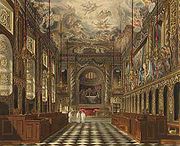The Clifton Star Chamber Case or Clifton vs. Robinson was a court case of early modern England, in 1601, before the Star Chamber, concerning the abduction of children by choir schools.[1]
| Henry Clifton v. Robinson | |
|---|---|
 | |
| Court | Star Chamber |
| Full case name | Henry Clifton vs. The Blackfriars Company (Robinson, Gyles & Evans) |
| Decided | 1601 |
| Case history | |
| Subsequent action | none |
| Keywords | |
| |
The case
editIn 1601, Henry Clifton, a nobleman from Norfolk,[2] sued the Blackfriars company (headed by Gyles, Robinson, and Evans) for their abduction of his son Thomas, on 13 December 1600.[3] Clifton obtained a warrant from Sir John Fortescue, who granted it using his authority as a member of the Privy Council due to his connections and high social status.[4][5][6] The basis for the case was not that Thomas was forcibly impressed into the choir school (which was entirely legal) but that he was made to act in the plays of Children of the Chapel.[7]
Ostensible consequence
editIn 1606, possibly as a result of this case, the royal patent allowing the Master of the Children of the Chapel Royal to impress children into service was revised to stipulate that choristers who had been forcibly impressed would not be "used or employed as Comedians or Stage players."[8]
Importance of the case
editThe Clifton case is one of the only surviving objection records to the common practice of forcibly impressing boys into (ecclesiastical) choir schools in medieval and early modern England. It is notable that the objection is to the child's involvement in the controversial children's theatre companies of the period. Forcible impressment was royally condoned as seen in letters from Elizabeth I on 15 July 1597 for the Master of the Children of the Chapel.[7] The prevalence is evidenced by documents such as an authorization for the Chapel Royal in 1420 and An Ordinance of the Lordes and Commons Assembled in Parliament, for the Apprehending and Bringing to Condigne Punishment, All Such Lewd Persons as Shall Steale, Sell, Buy, Inveigle, Purloune, Convey, or Receive Any Little Children (9 May 1644).[7] Others such as Salmon Pavey, Avery Trussell, John Chappell, Nathan Field, John Motteram, Philip Pykman, and Thomas Grymes are known such impressees.[7][9]
References
edit- ^ "Henry Clifton". mapoflondon.uvic.ca. 2016. Retrieved 18 February 2020.
- ^ Heller, Herbert Jack (2000). Penitent Brothellers: Grace, Sexuality, and Genre in Thomas Middleton's City Comedies. Newark: University of Delaware Press. p. 123. ISBN 9780874137019.
- ^ Archives, The National (12 May 2016). "The National Archives - Kidnapped to order: child actors in Shakespeare's day". The National Archives blog. Retrieved 18 February 2020.
- ^ Jenstad, Janelle (29 September 2017). "Blackfriars Theatre". The Map of Early Modern London. University of Victoria. Retrieved 30 October 2017.
- ^ Forse, James H. (1993). Art Imitates Business: Commercial and Political Influences in Elizabethan Theatre. Bowling Green: Bowling Green State University Popular Press. pp. 191–194. ISBN 9780879725952.
- ^ Bullough, Vern L.; Bullough, Bonnie (1993). Cross Dressing, Sex, and Gender. Philadelphia: University of Pennsylvania Press. pp. 80–81. ISBN 9780812214314.
- ^ a b c d Ackroyd, Julie (2017). Child Actors on the London Stage, Circa 1600: Their Education, Recruitment, and Theatrical Success. Chicago, IL: Sussex Academic Press. pp. 4–58. ISBN 9781845198480.
- ^ Lamb, Edel (2009). Performing Childhood in the Early Modern Theatre: The Children's Playing Companies, 1599-1613. Basingstoke: Palgrave Macmillan. p. 10. ISBN 978-0230202610.
- ^ Corrigan, Brian Jay (2004). Playhouse Law in Shakespeare's World. Madison: Fairleigh Dickinson University Press. pp. 74–75. ISBN 9780838640227.